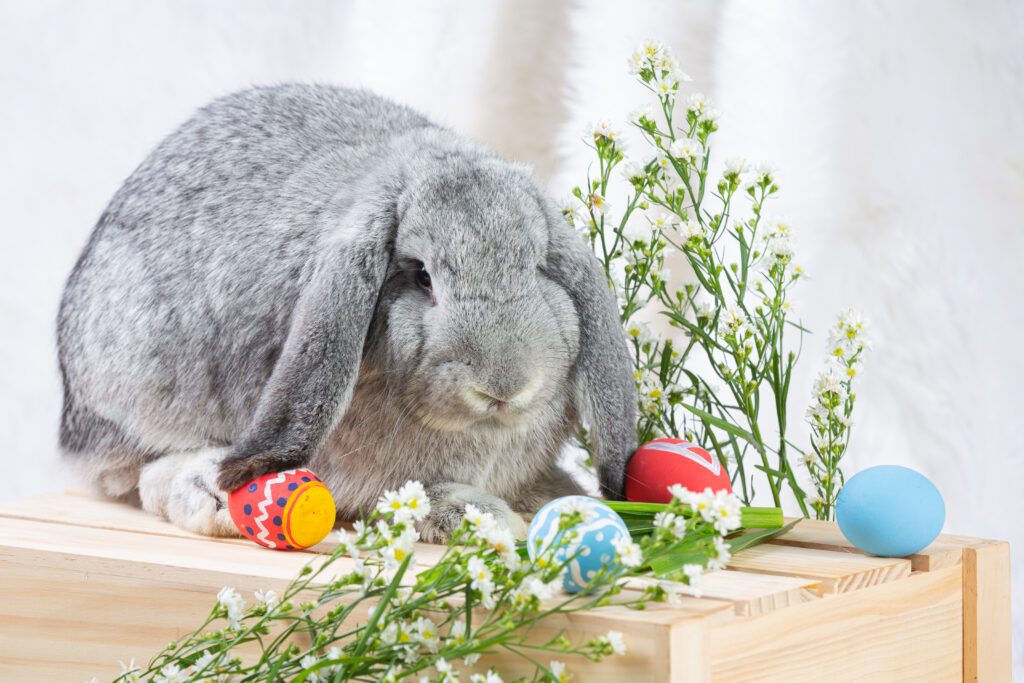In addition to its religious tenor, Easter time typically conjures up images of brightly colored eggs, jellybeans, marshmallow chicks, and pastel foil-wrapped chocolate candy in baskets, delivered by the Easter Bunny.
But, before you bite off the head of that chocolate bunny, let’s take a moment to consider where our Easter traditions originated.
Did you know that most of our cherished Easter traditions come from Pennsylvania German settlers who introduced them to America? The Easter Bunny, Easter Eggs, and Easter candy all have their roots in German traditions.
History:
Prior to the European Medieval period, Germanic Anglo-Saxon tribes celebrated the return of the light during the spring equinox (March 20). Eastre (also known as Ostara), goddess of the dawn, rebirth, fertility, and spring, and her companion hare, were worshiped during the annual festivals.
According to legend, Eastre found a wounded bird during the late winter. She saved its life by changing it into a hare; however, it still had the ability to lay eggs. The hare decorated the eggs and left them as gifts of appreciation for Eastre. Bunnies, and another familiar Easter icon, the egg, symbolize fruitfulness and the springtime season.
In order to win converts, early Christian missionaries paired the Christian celebration of the resurrection of Jesus Christ with the festival for Eastre. In 325 A.D., The First Council of Nicaea established that “Easter” would be celebrated on the first Sunday after the full moon following the spring equinox. Both spring celebrations, which symbolized rebirth and rejuvenation, occurred at a time when the earth was coming alive again with spring flowers and foliage. Christian Easter traditions are also calendrically and symbolically linked to the Jewish Passover, with Christ portrayed as a sacrificial lamb.
The Easter Bunny:
The most prominent secular symbol of the Christian holiday, the Easter bunny, was introduced to America by the German immigrants who brought over their stories of an egg-laying hare.
In the late 1600s, Lutheran Pennsylvania German settlers brought the Oschderhaas or Osterhase (Easter Hare) tradition with them to the New World. The first known reference to the Osterhase was seen in German literature from the 15th century. On the night before Easter, a child would use a bonnet or hat to make a nest that would be placed in a secluded spot in the garden, home, or barn. If his or her behavior had been good, a reward of colored eggs (Oschdereier), candy, and perhaps a small toy would be found in the nest on Easter morning. Bad children would be left with empty nests (or nests filled with rabbit droppings).
Eventually, the custom spread across the U.S. and the fabled rabbit’s Easter deliveries expanded to include colored eggs, chocolate, and other types of candy and gifts, while decorated baskets replaced nests. In addition, children often left out carrots in case the Easter Bunny got hungry from all his hopping.
Rabbits and Eggs?:
At first glance, and outside of the legend of Eastre and the Osterhase, it doesn’t seem like chicken eggs have much to do with rabbits. But chickens and rabbits can actually co-habitat in the same enclosure. Rabbits don’t see chickens or eggs as prey and are gentle enough not to break the eggs. In some cases, bunnies will even keep the eggs warm if a mother hen is absent. It’s easy to see a young child going to feed the chickens and finding a rabbit resting on an egg, and then having their imagination run wild. During the spring, chickens begin laying more eggs; after laying hardly any eggs all winter – it’s a little overwhelming to find uses for them all. Perhaps the abundance of eggs in the spring resulted in the persistence of egg decorating traditions. Eggs can be simply dyed, intricately painted, carved, or pierced, or a combination of all of these techniques.
Egg Decorating:
The egg, an ancient symbol of new life, has been associated with pagan festivals celebrating spring. From a Christian perspective, Easter eggs are said to represent Jesus’ emergence from the tomb and resurrection. Decorating eggs for Easter is a tradition that dates back to the 13th century. History says that eggs were formerly a forbidden food during the Lenten season so people would paint and decorate them to mark the end of the period of penance and fasting, and then eat them on Easter as a celebration.
Though decorating Easter eggs is not exclusively a German tradition, it grew in popularity with Pennsylvania Germans during the 1800s, and they played a part in introducing the custom to the U.S. They had their own style of decorating that featured folk art motifs like flowers, hearts, and birds. The eggs were colored using natural dyes from plants. Designs, often elaborate, were drawn onto the egg with wax, and then the egg was placed into the dye. Onion skin, the most used plant, produced a red-brown color.
Another way to decorate eggs was through scratch art. This tradition existed at least as long ago as 1789. The eggs were dyed a dark color and designs –typically flowers, trees, birds, rabbits, or geometrical patterns – were scratched into the surface with a pin or sharp penknife.
The Amish women use calico to cover their eggs. Sometimes the entire egg is covered with strips of cloth, but sometimes interesting designs of cloth are pasted on the blown egg and then outlined with binsa-graws. Today in the Pennsylvania Dutch country these designs are being painted upon the eggs themselves.
It is well-documented that Germans would dye their eggs and use them in conjunction with Easter. The tradition in Germany was to decorate the branches of trees and bushes with eggs for Easter, and when German immigrants arrived in Pennsylvania, they brought this custom with them. They would hang colored eggs on branches of outdoor trees and bushes and on cut branches inside homes as decorations. Among the Pennsylvania Germans the first Easter Egg Trees were garden trees or bushes hung with empty eggshells, while the indoor tree has no documentation before 1876 when a Reading, Pennsylvania newspaper commented on the innovation in the home of a druggist. Since 1950 the Egg Tree has become well known in the United States through a children’s book, The Easter Egg Tree, by Katherine Milhous of Philadelphia.
Easter egg hunts and egg rolling are two popular traditions. The White House Easter Egg Roll began in 1878 when Rutherford B. Hayes was president and continues as an annual event held on the Monday after Easter.
Modernism:
Consumption of Easter candy is among the modern additions to the celebration of this early springtime holiday…. And Easter is second only to Halloween for candy purchases in the United States. The most popular sweet treats are chocolate eggs and jelly beans.
Real eggs eventually gave way to chocolate confections as the treat of choice for Easter nests and baskets. In the mid to late 1800s, Easter chocolate (mostly varieties of hand-made chocolate eggs) became popular in major U.S. cities.
During the early 1900s, chocolate makers—including the Hershey Chocolate Company—created chocolate bunnies, eggs, chicks, and other Easter-themed shapes using metal molds. Molds allowed manufacturers to create Easter candy on a mass scale, and demand continued to grow. Today, stores stock an extensive variety of Easter candy, not to mention the treats available at privately-owned confectionery shops!
The jellybean became associated with Easter in the 1930s. According to the National Confectioners Association, over 16 billion jellybeans are made in the U.S. yearly for Easter, enough to fill a giant egg measuring 89 feet high and 60 feet wide.
Edible bunnies, made of pastry and sugar, didn’t appear on the scene until after the 1800s. Today, the top-selling non-chocolate Easter candy is the marshmallow Peep. Bethlehem, Pennsylvania-based candy manufacturer Just Born, founded by Russian immigrant Sam Born, makes peeps. Born began selling Peeps in 1950. The original Peeps were hand-made, marshmallow-flavored yellow chicks. Later, other shapes and flavors were introduced.
Did you know the largest Easter egg ever made was over 25 feet high and weighed over 8,000 pounds? It was built out of chocolate and marshmallow and supported by an internal steel frame.
If you were lucky enough to nab extra eggs at the grocery store, you might be thinking it’s time to get them ready for Easter.
Ready to try dying eggs the traditional way?
You’ll need those onion skins – 10-12 onions worth. You can either buy all of those onions, peel 
A side note before you start. Pennsylvania Dutch moms and grandmas learned over time. The number of dips is more important than the time spent in the dye. Put the eggs through a few cycles of dipping, drying, and dipping again and you’ll get a deeper color.
You’ll need 4-4.5 cups water, some white vinegar (about 3 tablespoons), and your dozen hard-boiled eggs (mixed are nice).
In a medium (3-quart) stainless steel saucepan, combine the onion skins, water, and vinegar. Use a spoon to stir all the onion skins into the water. Bring up to a boil. Then simmer for a while. I’ve seen recommendations for 20 minutes up to 30 minutes.
Next, you need to strain the mixture into a non-reactive measuring cup or bowl and allow it to cool. It doesn’t have to be cold…but you don’t want to boil the eggs. Use a slotted spoon to gently lower the eggs into the dye.
The longer they soak, the darker they will be. Then, remove the eggs from the dye with the slotted spoon and allow them to cool on a wire rack. Yellow onion skins will dye the eggs a light tan, while red onion skins will yield a richer brown color.


